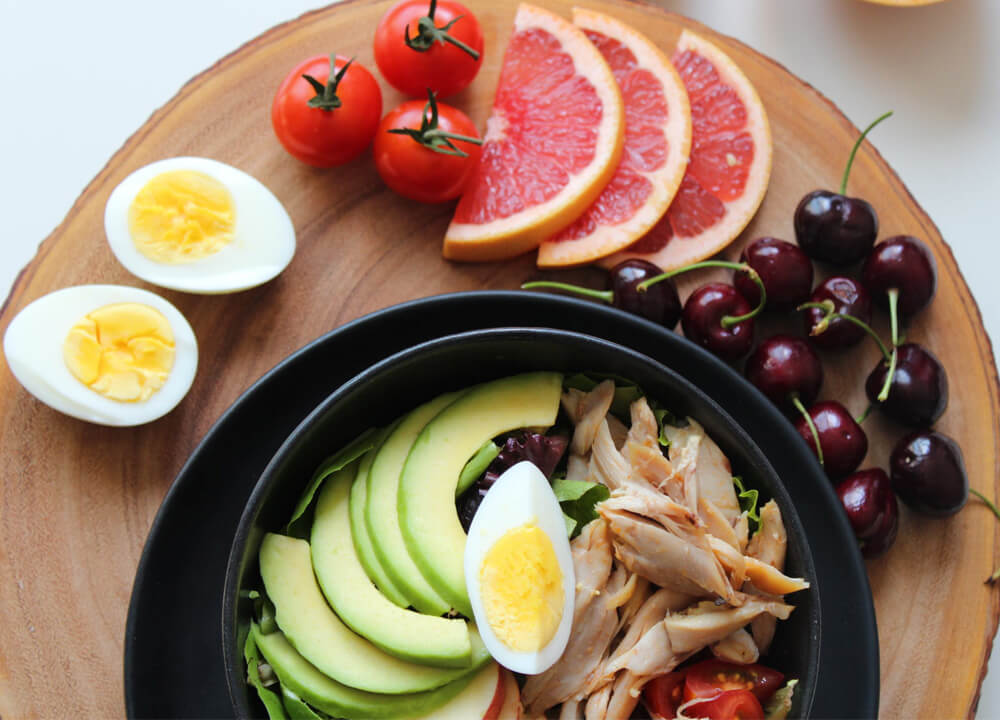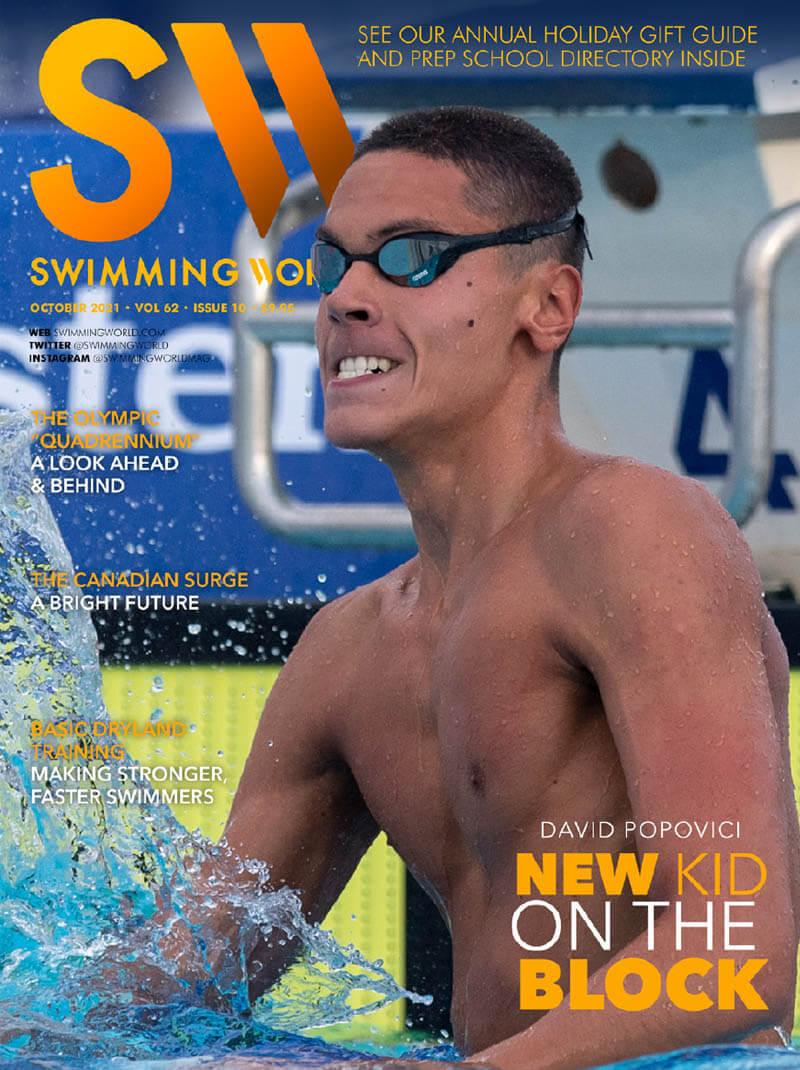Swimming World October 2021 Presents – Nutrition: Know Thyself – By Dawn Weatherwax

The latest issue of Swimming World Magazine
is now available for download in the Swimming World Vault!
Non-Subscribers Can Download This Issue Here
Nutrition: Know Thyself
By Dawn Weatherwax
Knowing your body composition can help you swim fast and stay healthy.
As athletes begin a new season and set goals, it is important to know their body composition. It is an essential piece of the goal-setting process. Having a certain body-fat-to-muscle-mass ratio is definitely related to athletic performance. The correct portion of muscle mass increases strength, power, agility and speed.
The American College of Sports Medicine recommends the following body fat percentages for women and men:

However, to gain lean muscle, it is not just about the exercise protocol, but nutritional intake and timing.
Research shows three out of four student-athletes may not be getting enough to eat. It also shows that 70% of the women and 73% of the men are not getting enough total calories…only 81% of the women and 90% of the men are consuming enough carbohydrates… and just 68% of the women and 81% of the men are eating enough protein based on USDA guidelines, NOT athletic guidelines.
Intakes of salt, total fat, saturated fat and cholesterol often exceed recommendations, even in diets deficient in major components.
To help achieve goals, athletes should know their body composition. But body composition is much more than a body fat percentage number. Following are different ways the measurement can be utilized.
Knowing your body fat percentage…
1. Creates goals for the season: Nutrition and exercise gets adjusted based on future testing outcomes.
2. Assists in the type of fuel mixture an athlete needs: If an athlete has a higher body fat, they usually need fewer calories and fewer carbohydrates. The opposite is true if the athlete has a low body fat. They usually need more calories and carbohydrates due to more lean weight.
3. Measures effectiveness of the training and nutrition strategy
4. Evaluates both lean weight and body fat: Some athletes need to gain muscle, others need to lose body fat, while some need to do both. This gives a scientific approach on where to go. The scale is NOT a good tool. For example, one of my athletes showed after doing a bod pod, they would be better off if they gained eight pounds of muscle and lost five pounds of fat. That’s crazy since they would be weighing three more pounds on the scale.
5. Provides reassurance when needed: Some athletes believe when they gain weight, they are gaining fat. Athletes can exchange fat at the same rate they gain muscle, so the scale is not displaying the positive exchanges.
Dawn Weatherwax (RD, CSSD, LD, ATC, CSCS) is a registered/licensed dietitian with a specialty in sports nutrition and founder of Sports Nutrition 2Go. She is also a board-certified specialist in sports dietetics, which is the premier professional sports nutrition credential in the United States. In addition, she is an athletic trainer with a certification in strength and conditioning from The National Strength and Conditioning Association, and she is CEO of Dawn Weatherwax’s Sports Nutrition Academy.
Weatherwax brings a comprehensive and unique understanding of the athlete’s body—and its nutritional needs—to those interested in achieving specific performance goals and optimal health. She is also the author of “The Official Snack Guide for Beleaguered Sports Parents,” “The Complete Idiot’s Guide to Sports Nutrition” and “The Sports Nutrition Guide for Young Athletes.”
 [PHOTO BY GEORGIO SCALIA / DEEPBLUEMEDIA]
[PHOTO BY GEORGIO SCALIA / DEEPBLUEMEDIA]
Get Swimming World Magazine and Swimming World Biweekly FREE When You
Become A Member of the International Swimming Hall of Fame
New! 30 Day Membership to ISHOF AND Digital Swimming World Subscription for just $10 a month!
Want more? Get a 1 Year ISHOF Family Membership With Swimming World Print AND Digital Subscription
Non-Subscribers can click here to download this issue for only $5.94
FEATURES
010 THE OLYMPIC “QUADRENNIUM:” A LOOK BACK AND A LOOK AHEAD
by David Rieder
Swimming World reflects on the last five years since the last Olympic Games in Rio and ponders the questions that lie ahead during the next three years leading up to Paris 2024.
014 A CANADIAN SURGE
by Matthew De George
Swimmers from Canada exceeded expectations at the Tokyo Games. And the Canadian delegation showed that the future is as bright as the present, with prolific young talents on both sides of the competition.
020 ISHOF FEATURE: AQUATOTS MURDER CASE—THE KATHY TONGAY STORY (Part 1)
by Bruce Wigo
It is doubtful that in the annals of aquatic history, there has ever been an example of abusive parents like the story of “little Kathy Tongay.”
024 EXPECT GREAT THINGS!
by John Lohn
David Popovici just turned 17 years old, but the Romanian sprint freestyler appears poised to follow a path to prominence.
031 NUTRITION: KNOW THYSELF
by Dawn Weatherwax
Knowing your body composition can help you swim fast and stay healthy.
COACHING
029 BASIC DRYLAND TRAINING
by Michael J. Stott
A concentrated, ongoing strength and conditioning regimen provides a quality supplement to in-pool training, helping swimmers become stronger and faster. Coaches Ron and Rich Blanc of Santa Margarita Catholic High School in Southern California share last season’s dryland training schedule that helped his girls’ and boys’ teams become national powers.
030 WEIGHT ROOM COMMON SENSE
by J.R. Rosania
These “Do’s and Dont’s” are courtesy of exercise scientist J.R. Rosania, whose performance enhancement firm Healthplex serves multisport athletes worldwide.
034 SWIMMING TECHNIQUE CONCEPTS: MAXIMIZING SWIMMING VELOCITY (Part 5): MINIMIZING THE ARM RECOVERY PHASE
by Rod Havriluk
The greatest possible time decreases for additional swimming velocity increases are in the non-propulsive phases (entry and recovery). This article includes strategies to minimize the recovery phase time of all four strokes.
045 Q&A WITH COACHES RON & RICH BLANC
by Michael J. Stott
046 HOW THEY TRAIN MAGGIE McGUIRE & JACK NUGENT
by Michael J. Stott
TRAINING
033 DRYSIDE TRAINING: BACK TO BASICS (Part 1)
by J.R. Rosania
JUNIOR SWIMMER
044 UP & COMERS: MARYJANE (MJ) NEILSON
by Shoshanna Rutemiller
COLUMNS & SPECIAL SECTIONS
008 A VOICE FOR THE SPORT
009 DID YOU KNOW: ABOUT FAMOUS GUYS WHO GOLF?
016 HOLIDAY GIFT GUIDE
036 PREP SCHOOL DIRECTORY`
048 GUTTERTALK
049 PARTING SHOT
Swimming World is now partnered with the International Swimming Hall of Fame. To find out more, visit us at ishof.org



